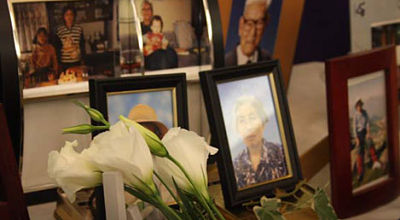Japan Church Looks to Hope of Resurrection
As church members and guests entered the sanctuary of Kitahama International Bible Church in Osaka, Japan, Sunday, they were greeted by dozens of white roses so fragrant and lovely that they seemed to be rivaling melodious notes rising from the featured violin.
For all their beauty, however, the rose buds represented something many would call ugly—the sting of death.
On the same day that the United States remembered the horrific events of Sept. 11, 2001, people across Japan memorialized a tragedy of a different nature—the March 11 earthquake and subsequent tsunami that claimed approximately 20,000 lives and more than 800,000 homes in the Tohoku region.
The Japanese Red Cross Society estimates that 400,000 people were displaced by the 9.0 temblor. Waves from the tsunami inundated the Fukushima Dai-ichi nuclear power plant, triggering the worst nuclear accident since Chernobyl.
Up and down the devastated northeast coast, families and communities came together to remember victims. Survivors prayed and monks chanted. At precisely 2:46 p.m., they stopped and observed a moment of silence.
At Kitahama, those who gathered memorialized loved ones who died in the last year. The service was designed to demonstrate to Buddhists around them that Christians also respect their dead. “The difference for the Christian is that death has lost its sting,” said Pastor Teiichiro Kuroda. “Death for Christians is the beginning of a new life. We don’t worship our dead.”
At a midway point in the service, congregants streamed forward and taking a white rose from the stack, gently placed it on the altar in front of their loved one’s photo. The service, designed so Christians could invite nonbelieving friends and family members to attend, featured worship and popular secular songs that portrayed both the sorrow of death and the hope of the resurrection.
Rev. Teiichiro spoke about the recent Sept. 4 typhoon that swept away the wife and daughter of Mayor Shinichi Teramoto on the very day of the daughter’s engagement. “I don’t know what to say for his heart that aches beyond our imagining. We sometimes face what we can’t avoid, sad and painful things in our lives.
“When people face trials,” Teiichiro added, “there is a significant difference between he who stands on the firm axis of Jesus Christ and he who doesn’t.”
The pastor shared a story from his own life as another example: “When I was in junior high school, 5,000 people died in a single night in the largest flood in Japan’s history. Water came into my house, too. It rose up to my chest, but I was spared. I wondered why so many others had to die. You might wonder too.”
Rev. Teiichiro went on to share the hope found in the gospel of John 11:17-27, concluding with an invitation for those present to put their faith in the promise of the resurrection.
“We Know Their Pain”
Although none of the Kitahama Church members lost loved ones in the March 11 disaster, several had wrestled with grief after neighbors died in the Jan. 17, 1995, Kobe earthquake.
Hiroko Komai was boiling water for tea when the 7.2 magnitude temblor struck that morning. The ground shook so hard that the pan of water jumped off the stove, scalding her legs severely.
She described how doctors in the Kobe hospital’s emergency room ran out of death certificates. “I saw in the examining room next to mine that the doctor had to write the time of death on a baby’s hand.”
Hiroko’s nephew tried to pull a dying man out of the rubble, but succeeded only in removing the top portion of his torso.
“Such horrors caused us to be kind and gentle to each other for a while after the Kobe earthquake,” said Hiroko. “At the same time, many people struggled with wondering ‘why?’ They had no salvation, no hope. Some people told us to curse heaven. Many still carry the trauma.”
Sixteen years later, Hiroko herself still panics when her washing machine shakes.
When she heard about the Tohoku earthquake, Hiroko’s heart broke. “We are frustrated that we can’t help more, because we know their pain,” she added.
Yumiko Tani also survived the Kobe earthquake, but with a few scars. Then a high school student, her main memory is of neighbors running around screaming, “My brother is dead!” “My son is dead!” And the date sticks in her head. “I can’t forget Jan. 17. Every year, I relive the agony. I still can’t watch TV on that day.”
The sound of helicopters triggers bad memories for Yumiko. “Even now I feel angry and sad when I hear one fly overhead.”
Yumiko and Kiroko each expressed feeling guilty that they survived the earthquake when so many around them died. They also share a deep empathy for the Tohoku victims. “We understand their emotions. They must be angry and sad too,” said Yumiko.
“People need to know what it is like to experience such a thing, whether it was the Kobe earthquake or Tohoku,” Kiroko added. “We have learned that life is precious and that the Japanese people are strong. We can help other people.”
“Yes, please hear our stories,” Yumiko said. “It is important to us that people around the world know.”
Used with permission of the Billy Graham Evangelistic Association.














































